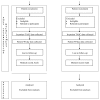Fever, hyperglycaemia and swallowing dysfunction management in acute stroke: a cluster randomised controlled trial of knowledge transfer
- PMID: 19291323
- PMCID: PMC2663544
- DOI: 10.1186/1748-5908-4-16
Fever, hyperglycaemia and swallowing dysfunction management in acute stroke: a cluster randomised controlled trial of knowledge transfer
Abstract
Background: Hyperglycaemia, fever, and swallowing dysfunction are poorly managed in the admission phase of acute stroke, and patient outcomes are compromised. Use of evidence-based guidelines could improve care but have not been effectively implemented. Our study aims to develop and trial an intervention based on multidisciplinary team-building to improve management of fever, hyperglycaemia, and swallowing dysfunction in patients following acute stroke.
Methods and design: Metropolitan acute stroke units (ASUs) located in New South Wales, Australia will be stratified by service category (A or B) and, within strata, by baseline patient recruitment numbers (high or low) in this prospective, multicentre, single-blind, cluster randomised controlled trial (CRCT). ASUs then will be randomised independently to either intervention or control groups. ASUs allocated to the intervention group will receive: unit-based workshops to identify local barriers and enablers; a standardised core education program; evidence-based clinical treatment protocols; and ongoing engagement of local staff. Control group ASUs will receive only an abridged version of the National Clinical Guidelines for Acute Stroke Management. The following outcome measures will be collected at 90 days post-hospital admission: patient death, disability (modified Rankin Score); dependency (Barthel Index) and Health Status (SF-36). Additional measures include: performance of swallowing screening within 24 hours of admission; glycaemic control and temperature control.
Discussion: This is a unique study of research transfer in acute stroke. Providing optimal inpatient care during the admission phase is essential if we are to combat the rising incidence of debilitating stroke. Our CRCT will also allow us to test interventions focussed on multidisciplinary ASU teams rather than individual disciplines, an imperative of modern hospital services.
Trial registration: Australia New Zealand Clinical Trial Registry (ANZCTR) No: ACTRN12608000563369.
Figures
References
-
- National Stroke Foundation . National Stroke Audit Clinical Report Acute Services. Victoria: NSF; 2007.
-
- Wang Y, Lim LL, Levi C, Heller RF, Fisher J. Influence of admission body temperature on stroke mortality. Stroke; A Journal Of Cerebral Circulation. 2000;31:404–409. - PubMed
-
- Azzimondi G, Bassein L, Nonino F, Fiorani L, Vignatelli L, Re G, D'Allessandro R. Fever In Acute Stroke Worsens Prognosis. Stroke. 1995;26:2040–2043. - PubMed
LinkOut - more resources
Full Text Sources



